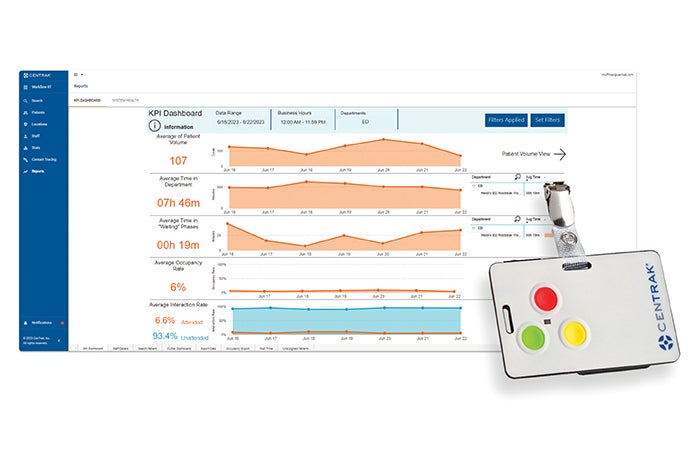Using RTLS to improve ED experience

CenTrak’s workflow automation solution has optimized the patient experience at Atrium Health Wake Forest Baptist Medical Center.
Image courtesy of CenTrak
Atrium Health Wake Forest Baptist is an academic health system based in Winston-Salem, N.C., and part of Atrium Health Enterprise. The emergency department (ED) at Atrium Health is a Level I adult and pediatric trauma center that provides emergency care and services to approximately 500,000 patients each year.
The past few years of the COVID-19 pandemic have caused significant care disruptions. In response to receiving lower scores on a patient experience survey via NRC Health, the ED’s patient experience enhancement team partnered with CenTrak, Newtown, Pa., in 2021 to develop a patient experience initiative leveraging real-time location systems (RTLSs) technology. The team’s goal was to use RTLSs to optimize resources, streamline workflows and create the “ultimate patient experience.”
Implementation consisted of workflow planning, system configuration and 12,000 RTLS-enabled employee badges. The ED team looked forward to utilizing the robust data and insights supplied by RTLSs. By using location technology, health care decision-makers gain data insights that are real, unbiased and actionable. This information creates the groundwork for leadership discussions by leveraging real data that spans many years.
“We’ve tested just about every new approach and technology to enhance the patient care journey throughout my 35 years as director of patient experience, and I’ve been impressed that RTLS data is so insightful and has aided the enhanced patient experience in the ED,” says Amanda Smith, M.Ed., CPXP, director of the office of patient experience. “The technology makes clean, actionable data easily accessible. In fact, the metrics have encouraged me to pursue RTLS advancement throughout the EDs in our health system. The insights are a game-changer.”
The Atrium Health medical center utilized CenTrak’s workflow automation platform to improve the patient experience and operational performance. As a result, staff now can quickly gather baseline information that is necessary to register patients. Clinical and registration staff then go into their RTLS workflow platform and select a call button, immediately notifying patients of the next steps in their care journey.
Through the platform, approved family members remain informed of a patient’s status via text messaging updates. Also, families can view board monitors that display HIPAA-compliant patient names and phases of care in waiting areas, providing 50% more visibility within the main ED waiting lobby and triage areas.
As another initiative, the hospital leverages its RTLS staff duress technology to give patients real-time input on the facility’s performance. The team mounted staff duress buttons within a wall unit in six public restrooms in the adult ED. Another six buttons will soon be placed within public restrooms in the pediatric ED. If a patient, family member or team member feels that the facilities need attention (e.g., supplies or cleaning), a sign instructs them to press the yellow alert button on the wall. This notifies environmental services (EVS) that a specific restroom requires urgent maintenance attention. EVS staff members are assigned an Ascom telephone, called “ED Support,” that receives the notification as a text message when the yellow button is pushed.
“We knew RTLSs could make a difference, and we are pleased with the ongoing results,” says Frances Charlton, R.N., DNP, MBA, MHA, NE-BC, director of nursing and clinical operations for the ED and heart and vascular service line. “Our team continues to partner with CenTrak to identify additional uses of the RTLS technology to enhance the overall patient experience even more.”
The value of real-time technologies at Atrium Health Wake Forest Baptist is measurable and sustainable. Over the course of the year, patients’ likelihood of recommending the ED increased by nearly 20%. During the past five months, with the implementation of the various initiatives and the use of actionable data, scores now surpass the average NRC Health score and Atrium Health’s targets.
Qualitative key performance indicators — such as wait time, communication, recognition and responsiveness — continue to trend positively. Facilitywide, Atrium Health Wake Forest Baptist has successfully implemented more than 50 RTLS use cases, all with positive results.

